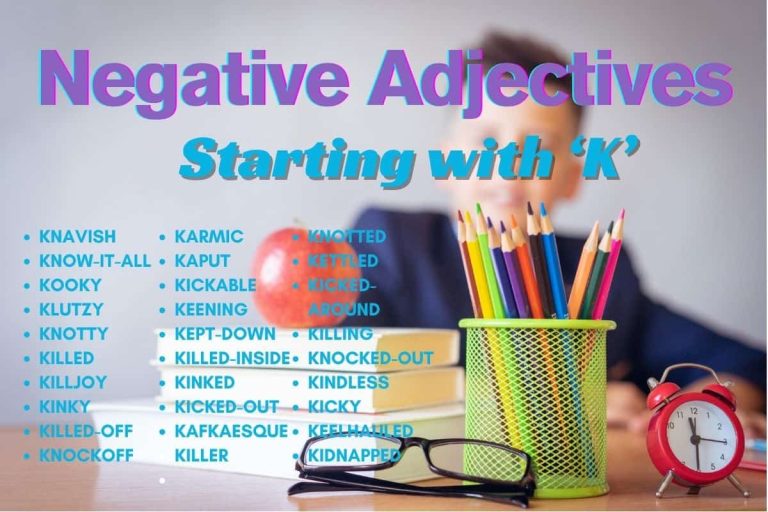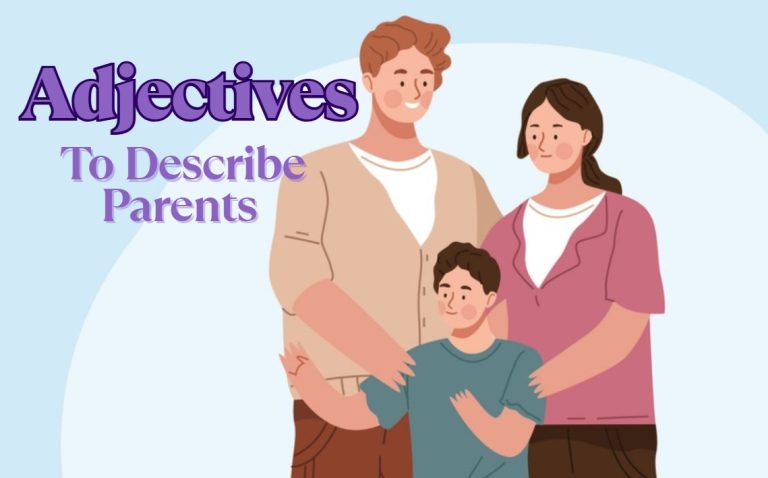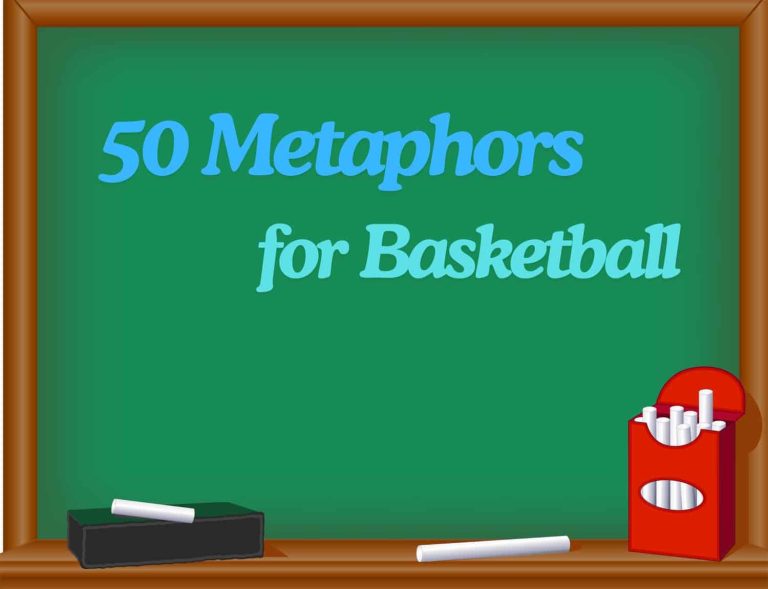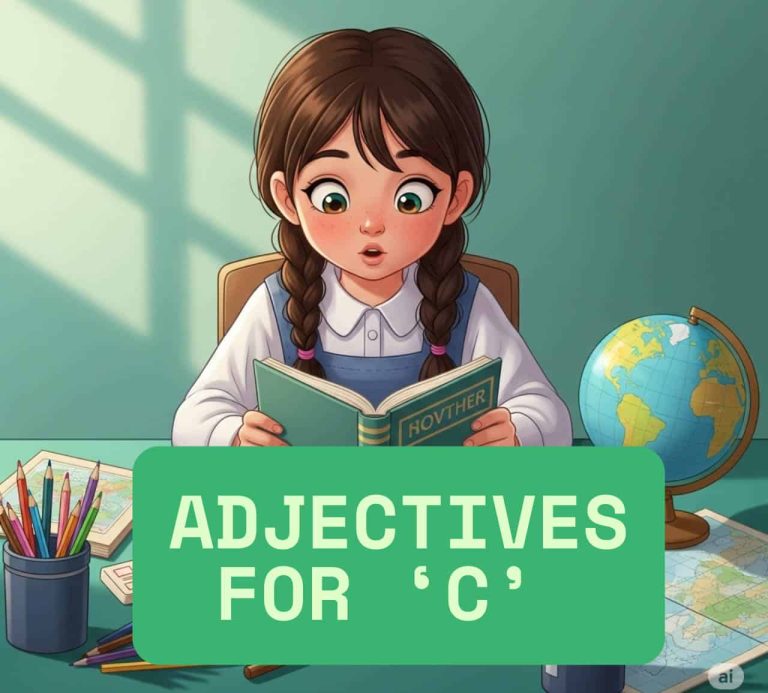50 Exploring Metaphors for Nice in English
The English language is rich with possibilities beyond the simple adjective “nice.” While “nice” is perfectly acceptable, relying on it exclusively can make your speech and writing sound repetitive and lack nuance. Understanding and utilizing metaphors for pleasantness allows you to express yourself more vividly, engagingly, and precisely.
This article delves into a variety of metaphorical expressions that convey different shades of “nice,” enriching your vocabulary and enhancing your communication skills. This guide is beneficial for English language learners, writers seeking more descriptive language, and anyone wanting to add flair and sophistication to their everyday conversations.
Defining Metaphors for “Nice”
A metaphor is a figure of speech that directly compares two unlike things without using “like” or “as.” It asserts that one thing is another, creating a vivid and often unexpected connection. In the context of describing something as “nice,” a metaphor replaces the literal adjective with a more evocative image or concept. The function of a metaphor is to add depth, color, and emotional resonance to language, making it more engaging and memorable.
Metaphors can be used in various contexts, from casual conversation to formal writing, to express nuanced feelings and create a stronger impact on the audience. They allow you to move beyond the blandness of “nice” and convey the specific quality of pleasantness you wish to highlight.
For example, instead of saying “She’s a nice person,” you might say “She’s a ray of sunshine,” using a metaphor to suggest her warmth and brightness. This adds a layer of meaning that the word “nice” alone cannot capture. Understanding the underlying meaning and connotations of different metaphors is crucial for using them effectively.
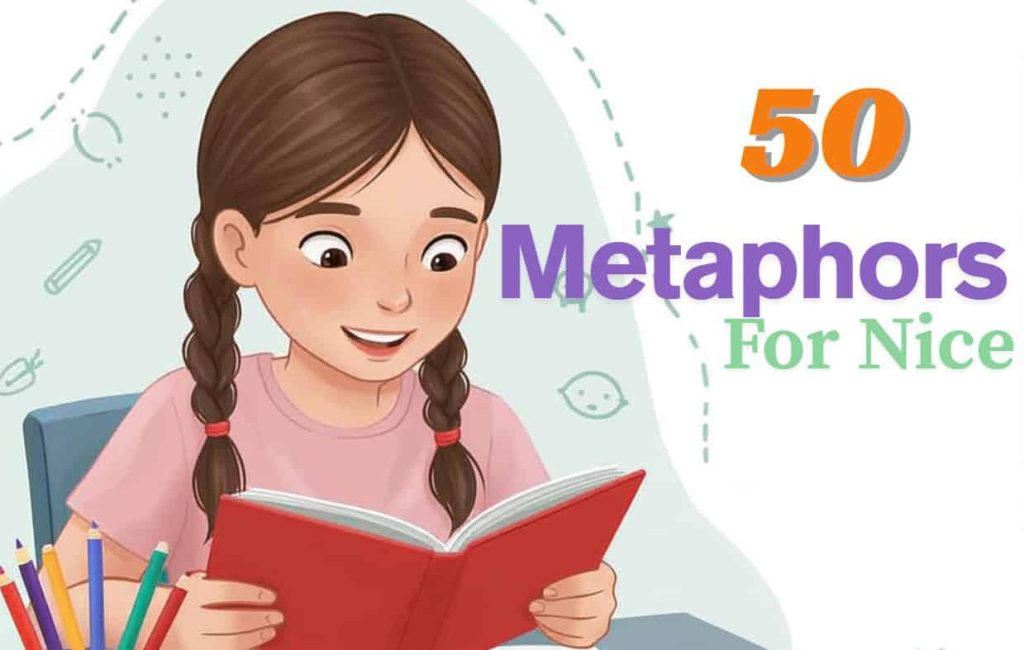
Types and Categories of Metaphors for “Nice”
Metaphors for “nice” can be categorized based on the imagery they evoke. This classification helps in understanding the different shades of meaning that can be conveyed through metaphorical language.
Sensory Metaphors
Sensory metaphors appeal to the five senses: sight, hearing, smell, taste, and touch. They describe something as “nice” by associating it with a pleasant sensory experience.
These metaphors are particularly effective because they create a vivid and immediate impression on the reader or listener.
For instance, describing someone’s voice as “velvet” evokes a sense of smoothness and luxury, suggesting that it is pleasing to the ear. Similarly, describing a place as “a feast for the eyes” suggests that it is visually stunning and delightful.
Weather-Related Metaphors
Weather-related metaphors use elements of weather to describe something as “nice.” These metaphors often convey feelings of warmth, brightness, and positivity. They can also suggest a sense of calm and tranquility.
For example, “She’s a ray of sunshine” suggests that someone is cheerful and brings happiness to others. “He’s a gentle breeze” might describe someone who is calm, soothing, and easy to be around.
The specific type of weather used in the metaphor can significantly alter the meaning.
Food-Related Metaphors
Food-related metaphors draw on the pleasures of taste and nourishment to describe something as “nice.” These metaphors often suggest that something is delightful, satisfying, or enriching. They can also convey a sense of indulgence and comfort.
For instance, “That’s the icing on the cake” implies that something is an added bonus that makes a situation even better. “She’s a sweet person” suggests that someone is kind, gentle, and agreeable.
The flavor or type of food used in the metaphor can add further nuance to the meaning.
Animal-Related Metaphors
Animal-related metaphors use the characteristics of animals to describe something as “nice.” These metaphors can convey a wide range of qualities, from gentleness and loyalty to playfulness and charm. The choice of animal is crucial in determining the specific meaning of the metaphor.
For example, “He’s as gentle as a lamb” suggests that someone is kind, innocent, and harmless. “She’s a real charmer” might describe someone who is captivating and delightful, like a playful kitten.
Different animals evoke different associations and emotions.
Nature-Related Metaphors (excluding weather & animals)
Nature-related metaphors, excluding weather and animals, encompass elements like plants, landscapes, and natural formations. These metaphors often convey feelings of peace, beauty, and growth.
They can also suggest a sense of resilience and harmony.
For instance, “She’s a blossoming talent” implies that someone is developing and flourishing. “He’s a solid foundation” suggests that someone is reliable and supportive.
The specific element of nature used in the metaphor can significantly alter the meaning, adding depth and nuance to the description.
Abstract Metaphors
Abstract metaphors use abstract concepts or ideas to describe something as “nice.” These metaphors often convey qualities such as harmony, balance, and perfection. They can also suggest a sense of elegance and sophistication.
For example, “It’s a symphony of flavors” implies that something is a harmonious and pleasing combination of elements. “She’s the embodiment of grace” suggests that someone is elegant, refined, and poised.
Abstract metaphors often require a deeper understanding of the underlying concepts to fully appreciate their meaning.
Examples of Metaphors for “Nice”
The following tables provide examples of metaphors for “nice,” categorized by type. Each example is designed to illustrate how different metaphorical expressions can be used to convey various shades of pleasantness.
Table 1: Sensory Metaphors for “Nice”
This table showcases metaphors that appeal to the five senses to describe something or someone as pleasant.
| Metaphor | Explanation |
|---|---|
| Her voice is velvet. | Her voice is smooth, rich, and pleasing to the ear. |
| The garden was a feast for the eyes. | The garden was visually stunning and delightful. |
| His laughter was like warm honey. | His laughter was sweet, comforting, and enjoyable. |
| The air was thick with the scent of lavender. | The scent of lavender made the air pleasant and relaxing. |
| The fabric felt like a gentle caress. | The fabric was soft, smooth, and pleasing to the touch. |
| The music was pure auditory bliss. | The music was extremely enjoyable and delightful to listen to. |
| The painting was a symphony of colors. | The painting had a harmonious and pleasing combination of colors. |
| The coffee had a silken texture. | The coffee was smooth and luxurious to drink. |
| The aroma of the bakery was a warm embrace. | The smell of the bakery was comforting and welcoming. |
| The sunset was a visual poem. | The sunset was beautiful and evocative, like a work of art. |
| Her touch was like a soothing balm. | Her touch was gentle and healing. |
| The sound of the rain was a lullaby. | The sound of the rain was calming and relaxing. |
| The taste of the dessert was heavenly. | The dessert tasted extremely delicious and delightful. |
| The view from the mountain was breathtaking. | The view was stunning and awe-inspiring. |
| The feeling of the sun on my skin was pure joy. | The warmth of the sun felt wonderful and joyful. |
| The fragrance of the flowers was intoxicating. | The scent of the flowers was captivating and delightful. |
| The sound of the waves was a peaceful melody. | The sound of the waves was calming and soothing. |
| The texture of the silk was exquisite. | The silk felt luxurious and refined. |
| The light in the room was soft and inviting. | The light created a warm and welcoming atmosphere. |
| The taste of the tea was a comforting ritual. | The tea tasted pleasant and provided a sense of comfort. |
| His smile was a ray of sunshine. | His smile was bright and cheerful, bringing happiness to others. |
| The music was a gentle breeze on a summer evening. | The music was light, refreshing, and pleasant. |
| Her laughter was like the tinkling of bells. | Her laughter was light, clear, and cheerful. |
This table illustrates how weather elements can be used metaphorically to describe pleasantness.
| Metaphor | Explanation |
|---|---|
| She’s a ray of sunshine. | She’s cheerful and brings happiness to others. |
| He’s a gentle breeze. | He’s calm, soothing, and easy to be around. |
| The day was bathed in golden light. | The day was bright, warm, and beautiful. |
| Her smile is like a warm summer day. | Her smile is bright, cheerful, and welcoming. |
| His words were a refreshing rain after a drought. | His words were revitalizing and welcome after a period of difficulty. |
| She’s a rainbow after the storm. | She brings hope and beauty after a difficult time. |
| His presence is like a calm sea. | His presence is peaceful and reassuring. |
| The atmosphere was as bright as midday. | The atmosphere was cheerful and lively. |
| Her kindness is a gentle snowfall. | Her kindness is soft, pure, and comforting. |
| His advice was like a guiding star. | His advice was helpful and illuminating. |
| She illuminates the room like the sun. | Her presence brightens and enlivens the atmosphere. |
| His calmness is like a clear sky. | His composure is serene and untroubled. |
| Her optimism is a warm front moving in. | Her positive outlook is invigorating and uplifting. |
| He’s a sturdy oak in the face of a storm. | He’s resilient and strong in challenging situations. |
| She is the calm after the storm. | She brings peace and tranquility after chaos. |
| His insights are as clear as a sunny day. | His understanding is straightforward and illuminating. |
| Her spirit is as boundless as the sky. | Her enthusiasm and energy are limitless. |
| He’s a beacon in the darkest night. | He provides guidance and hope when things are bleak. |
| She’s like a spring breeze bringing new life. | She’s refreshing and brings positive change. |
| His wisdom is as deep as the ocean. | His knowledge and understanding are profound. |
| The news was a refreshing breeze. | The news was welcome and revitalizing. |
| Her support is like a sheltering tree during a storm. | Her support provides comfort and protection. |
| His encouragement is like a gentle rain nourishing growth. | His encouragement helps others to develop and thrive. |
This table provides examples of how food-related metaphors can be used to describe something as “nice,” often implying that it is delightful or satisfying.
| Metaphor | Explanation |
|---|---|
| That’s the icing on the cake. | That’s an added bonus that makes a situation even better. |
| She’s a sweet person. | She’s kind, gentle, and agreeable. |
| The experience was a real treat. | The experience was delightful and enjoyable. |
| His words were pure honey. | His words were sweet, flattering, and persuasive. |
| The solution was a piece of cake. | The solution was easy and straightforward. |
| She’s the salt of the earth. | She’s honest, reliable, and down-to-earth. |
| His ideas are food for thought. | His ideas are stimulating and worth considering. |
| The music was a delicious melody. | The music was pleasing and enjoyable to listen to. |
| Her kindness is like a warm loaf of bread. | Her kindness is comforting and nourishing. |
| His generosity is the spice of life. | His generosity adds excitement and interest to life. |
| The opportunity was a golden nugget. | The opportunity was valuable and precious. |
| Her advice was a spoonful of sugar. | Her advice made a difficult situation easier to accept. |
| His stories are like a fine wine. | His stories are rich, complex, and enjoyable. |
| She’s a nourishing presence. | She provides support and helps others thrive. |
| His laughter is the best medicine. | His laughter is uplifting and healing. |
| Her encouragement is like a warm cup of coffee. | Her encouragement provides comfort and energy. |
| His words are as smooth as butter. | His words are charming and persuasive. |
| She’s a breath of fresh air. | She’s refreshing and brings positive change. |
| His friendship is a treasure. | His friendship is valuable and cherished. |
| Her support is like a strong foundation. | Her support is reliable and unwavering. |
| The experience was a sweet delight. | The experience was extremely pleasant and enjoyable. |
| Her singing voice is liquid gold. | Her singing voice is beautiful and precious. |
| His presence is like a warm blanket. | His presence is comforting and reassuring. |
This table explores metaphors that use animal characteristics to describe someone or something as “nice,” often highlighting qualities like gentleness or loyalty.
| Metaphor | Explanation |
|---|---|
| He’s as gentle as a lamb. | He’s kind, innocent, and harmless. |
| She’s a real charmer. | She’s captivating and delightful. |
| He’s a loyal friend. | He’s faithful, supportive, and trustworthy. |
| She’s as playful as a kitten. | She’s lively, energetic, and fun-loving. |
| He’s a wise owl. | He’s knowledgeable, insightful, and perceptive. |
| She’s a graceful swan. | She’s elegant, beautiful, and poised. |
| He’s a busy bee. | He’s hardworking, diligent, and productive. |
| She’s as free as a bird. | She’s independent, unconstrained, and carefree. |
| He’s a strong bear. | He’s powerful, protective, and dependable. |
| She’s as quick as a fox. | She’s intelligent, cunning, and resourceful. |
| He’s a social butterfly. | He’s outgoing, friendly, and enjoys socializing. |
| She’s a gentle dove. | She’s peaceful, kind, and compassionate. |
| He’s a steadfast turtle. | He’s patient, persistent, and reliable. |
| She’s as radiant as a peacock. | She’s beautiful, vibrant, and confident. |
| He’s a noble lion. | He’s courageous, dignified, and respected. |
| She’s as graceful as a gazelle. | She moves with elegance and agility. |
| He’s as alert as a hawk. | He’s sharp-eyed and observant. |
| She’s as busy as a beaver. | She’s industrious and hard-working. |
| He’s a gentle giant. | He’s kind and compassionate despite his imposing size. |
| She’s a nurturing mother hen. | She’s caring and protective. |
| He’s as playful as a puppy. | His is full of energy and fun-loving. |
| She’s as wise as an old owl. | She has great knowledge and understanding. |
| He’s as brave as a lion. | He is courageous and fearless. |
This table presents metaphors that use elements of nature (excluding weather and animals) to describe something as “nice,” often suggesting beauty or growth.
| Metaphor | Explanation |
|---|---|
| She’s a blossoming talent. | She’s developing and flourishing. |
| He’s a solid foundation. | He’s reliable and supportive. |
| The idea was a seed of inspiration. | The idea was the starting point for something creative and meaningful. |
| Her words were like a soothing balm. | Her words were comforting and healing. |
| He’s a towering presence. | He’s impressive, influential, and respected. |
| She’s a hidden gem. | She’s valuable and special, but not widely recognized. |
| His advice was a guiding light. | His advice was helpful, illuminating, and trustworthy. |
| The experience was a breath of fresh air. | The experience was refreshing, revitalizing, and welcome. |
| Her smile is like a blooming flower. | Her smile is beautiful, radiant, and cheerful. |
| His kindness is like a deep well. | His kindness is abundant, inexhaustible, and life-giving. |
| He’s a sturdy oak in a storm. | He’s resilient and unwavering in difficult times. |
| She’s a rare orchid. | She’s exquisite and unique. |
| His wisdom is a deep forest. | His knowledge is vast and complex. |
| She’s a mountain of strength. | She’s incredibly strong and resilient. |
| He’s a guiding compass. | He provides direction and helps others navigate challenges. |
| She’s a sparkling stream of inspiration. | She’s a constant source of creativity and ideas. |
| He’s a bedrock of support. | He provides a solid and reliable foundation. |
| She’s a field of wildflowers. | She’s vibrant, diverse, and beautiful. |
| His words are like fertile ground. | His ideas encourage growth and development. |
| She’s a tapestry of experiences. | She’s rich and complex, with a diverse background. |
| His laughter is like a babbling brook. | His laughter is cheerful and lighthearted. |
| She’s a valley of peace. | She provides serenity and tranquility. |
| His determination is like a mountain range. | His resolve is strong and unwavering. |
Usage Rules for Metaphors
While metaphors can greatly enhance your writing and speech, it’s important to use them correctly. Overusing metaphors can make your language seem convoluted and difficult to understand. The most important rule is to ensure that your metaphor is appropriate and relevant to the context. The connection between the tenor and the vehicle should be clear and logical. Avoid mixing metaphors, which can create confusing or nonsensical images.
For instance, avoid saying something like “He’s a ray of sunshine who’s also a solid rock.” While both metaphors are positive, they don’t quite fit together seamlessly. It’s also important to consider your audience when using metaphors.
A metaphor that is easily understood by one audience may be confusing to another. Simplicity is key.
Select a metaphor that resonates with your audience and effectively conveys your intended meaning.
Another consideration is the tone of your writing or speech. Metaphors can be used to create a variety of effects, from humorous to serious. Choose a metaphor that is consistent with the overall tone of your message.
Common Mistakes When Using Metaphors
One common mistake is using clichéd metaphors. These are metaphors that have been used so often that they have lost their impact and originality. Examples include “as busy as a bee” or “as gentle as a lamb.” While these metaphors are easily understood, they don’t add much to your writing or speech. Strive to create fresh, original metaphors that will capture your audience’s attention.
Another common mistake is mixing metaphors. This occurs when you combine two or more metaphors that don’t logically fit together. For example, “He’s a wolf in sheep’s clothing who’s also a ray of sunshine” is a mixed metaphor. The image of a wolf in sheep’s clothing clashes with the image of a ray of sunshine, creating a confusing and contradictory impression.
Table 6: Correct vs. Incorrect Metaphor Usage
This table illustrates common mistakes in metaphor usage and provides corrected examples.
| Incorrect | Correct | Explanation |
|---|---|---|
| He’s a wolf in sheep’s clothing who’s also a ray of sunshine. | He’s a wolf in sheep’s clothing. | Mixing metaphors creates a confusing image. |
| She’s as busy as a bee, running around in circles. | She’s working tirelessly to complete the project. | Avoid clichéd metaphors that have lost their impact. |
| The idea was a green light to success. | The idea was a seed of inspiration. | Choose metaphors that are relevant and appropriate. |
| He’s a rock and a rolling stone. | He’s a solid rock. | Conflicting metaphors create confusion. |
| Her voice was like nails on a chalkboard, but also like velvet. | Her voice was like velvet. | Contradictory metaphors undermine the intended meaning. |
Practice Exercises
The following exercises will help you practice identifying and using metaphors for “nice.”
Exercise 1: Identifying Metaphors
Identify the metaphor in each sentence and explain what it means.
| Question | Answer |
|---|---|
| 1. Her kindness is a warm embrace. | Metaphor: “warm embrace.” Meaning: Her kindness is comforting and welcoming. |
| 2. He’s a beacon of hope in difficult times. | Metaphor: “beacon of hope.” Meaning: He provides guidance and inspiration. |
| 3. The music was a soothing balm to her soul. | Metaphor: “soothing balm”. Meaning: The music was comforting and healing. |
| 4. She’s a fountain of creativity. | Metaphor: “fountain of creativity.” Meaning: She’s a constant source of new ideas. |
| 5. His words were a gentle rain on parched land. | Metaphor: “gentle rain.” Meaning: His words were refreshing and revitalizing. |
| 6. The experience was a slice of heaven. | Metaphor: “slice of heaven.” Meaning: The experience was extremely pleasant and enjoyable. |
| 7. Her laughter is the melody of joy. | Metaphor: “melody of joy.” Meaning: Her laughter is cheerful and uplifting. |
| 8. He is a mountain of strength. | Metaphor: “mountain of strength.” Meaning: He is incredibly strong and resilient. |
| 9. She’s a wellspring of inspiration. | Metaphor: “wellspring of inspiration.” Meaning: She is a constant source of motivation and ideas. |
| 10. His wisdom is a guiding star. | Metaphor: “guiding star.” Meaning: His wisdom provides direction and clarity. |
Rewrite each sentence using a metaphor to describe the underlined word.
| Question | Answer |
|---|---|
| 1. She is a kind person. | She is a ray of sunshine. |
| 2. He is a helpful friend. | He is a guiding star in my life. |
| 3. The music was pleasant. | The music was a soothing balm to my soul. |
| 4. Her smile was beautiful. | Her smile was a blooming flower. |
| 5. His advice was valuable. | His advice was a golden nugget. |
| 6. The news was welcome. | The news was a refreshing breeze. |
| 7. Her voice is soothing. | Her voice is velvet. |
| 8. His presence is comforting. | His presence is a warm embrace. |
| 9. The experience was delightful. | The experience was a slice of heaven. |
| 10. Her support is reliable. | Her support is a solid foundation. |
Identify and correct the mixed metaphors in the following sentences.
| Question | Answer |
|---|---|
| 1. He’s a rock who’s also skating on thin ice. | Corrected: He’s a rock. / He’s skating on thin ice. (Choose one) |
| 2. She’s a ray of sunshine who’s also a wolf in sheep’s clothing. | Corrected: She’s a ray of sunshine. / She’s a wolf in sheep’s clothing. (Choose one) |
| 3. His ideas are seeds of inspiration that are also running on fumes. | Corrected: His ideas are seeds of inspiration. |
| 4. Her voice is a soothing balm that also cuts like a knife. | Corrected: Her voice is a soothing balm. / Her words cut like a knife. (Choose one and adjust the sentence slightly) |
| 5. He’s a tower of strength who’s also drowning in a sea of troubles. | Corrected: He’s a tower of strength. / He’s drowning in a sea of troubles. (Choose one) |
| 6. The project is a piece of cake that’s also climbing an uphill battle. | Corrected: The project is a piece of cake. / The project is an uphill battle. (Choose one) |
| 7. Her laughter is music to my ears that’s also a thorn in my side. | Corrected: Her laughter is music to my ears. |
| 8. He’s a beacon of hope who is also a diamond is the rough. | Corrected: He’s a beacon of hope. / He’s a diamond in the rough. |
| 9. She’s a breath of fresh air who’s also burning the midnight oil. | Corrected: She’s a breath of fresh air. / She’s burning the midnight oil. |
| 10. His kindness is a warm blanket that also leaves a bad taste in your mouth. | Corrected: His kindness is a warm blanket. |
Frequently Asked Questions
- Q: Why use metaphors instead of just saying “nice”?
- A: Metaphors add depth, color, and emotional resonance to your language, making it more engaging and memorable. They allow you to express nuanced feelings and create a stronger impact on your audience.
- Q: How can I come up with original metaphors?
- A: Start by thinking about the specific qualities you want to convey. Then, brainstorm images, concepts, or experiences that evoke those qualities. Look for unexpected connections between the tenor and the vehicle.
- Q: Is it okay to use the same metaphor more than once?
- A: While it’s generally best to vary your language, using a metaphor more than once can be effective if it’s done deliberately and strategically. However, be careful not to overuse it, as this can make your writing or speech sound repetitive.
- Q: How can I tell if a metaphor is appropriate for my audience?
- A: Consider your audience’s background, knowledge, and values. Choose metaphors that are likely to resonate with them and effectively convey your intended meaning. If in doubt, err on the side of simplicity and clarity.
- Q: What if I’m not sure whether something is a metaphor or not?
- A: If you’re unsure whether something is a metaphor, ask yourself whether it’s a literal statement or a figurative one. If it’s a figurative statement that compares two unlike things without using “like” or “as,” it’s likely a metaphor.
- Q: Can metaphors be used in formal writing?
- A: Yes, metaphors can be used in formal writing, but they should be used judiciously and with careful consideration of the context. Avoid overly flowery or sensational metaphors, and ensure that your metaphors are clear, relevant, and appropriate for your audience.
- Q: How do I avoid mixing metaphors?
- A: Pay close attention to the images and concepts you’re using. Make sure that they logically fit together and don’t create contradictory or nonsensical impressions. If you’re not sure whether two metaphors can be combined, it’s best to avoid doing so.
- Q: Are there any online resources for finding metaphors?
- A: Yes, there are several online resources that can help you find metaphors, such as metaphor dictionaries and thesauruses. However, be careful not to rely too heavily on these resources, as it’s important to develop your own ability to create original metaphors.
Conclusion
Mastering the art of using metaphors for “nice” can significantly enhance your communication skills. By moving beyond the limitations of simple adjectives, you can express yourself more vividly, engagingly, and precisely.
Understanding the different types of metaphors, following usage rules, and avoiding common mistakes will enable you to create language that is both effective and memorable. Embrace the power of metaphorical language to add depth, color, and emotional resonance to your writing and speech, and unlock new levels of expressiveness.

